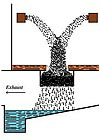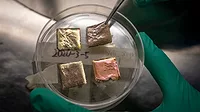An Energy-Saving Scrubber Solution

In the new scrubber, the air, overspray and dispersion chemistry pass through the labyrinth simultaneously. Since it does not rely on atomization, the scrubber requires less than half the energy to maintain scrubbing efficiencies equal to those of conventional venturi scrubbers.
Dispersion chemistry for scrubbing paint particulate emissions was originally developed by Nalco in the late 1980s and gained increased exposure when it was marketed by Phillips Service Corp. (PSC) in the mid 1990s. The chemistry provided outstanding performance compared to conventional "de-tack" programs in maintaining system cleanliness, increasing production uptime and substantially reducing system cleaning costs, and it appeared to be ideally suited for use in high production automotive assembly plants. Unfortunately, when the chemistry was used with conventional venturi scrubbers, portions of the oily dispersion/paint mixture were discharged from the exhaust stacks, requiring the use of additional (and often expensive) filtration equipment.
Today, advanced dispersion programs from PPG, Henkel, Omnichem and other companies are being used in Nissan, Honda, Budd, Magna, ASC and many other North American automotive plants. While these advanced dispersion chemistries are effective, finishing professionals have continued to look for alternative scrubber systems that would reduce costs and optimize paint booth efficiency.

Figure 1. Conventional venturi scrubbers use a high static pressure to atomize the dispersion chemistry and allow particle-to-particle contact for paint removal from the airstream.
Drawbacks of Conventional Technologies
Most finishing booths in use today were designed to work in conjunction with de-tack chemistry, in which water and de-tack polymers (or clay) are forced into a highly atomized state in a venturi scrubber to capture paint particles from overspray and carry the particles out of the booth and into a pit for eventual removal as waste (see Figure 1). While the technology is effective at capturing overspray at its optimum efficiency, it relies on a regulated flow of air and water through precise orifice dimensions to create the necessary static pressures required for atomization. Any interruptions in the air or water flow can cause serious problems in the spray booth's operation. For example, testing has shown that a 25% reduction of water flow in a conventional venturi scrubber can yield a 400% increase in paint particulate emissions. Additionally, a reduction or increase in airflow in the affected zone can create a negative booth balance due to overspray buildup, and production must be stopped to clear the foul.Advanced dispersion chemistries have practically eliminated the fouling problem. However, secondary dewatering baffles and mist eliminators often must be added to capture the exhaust stack discharge, and this extra equipment increases operational and maintenance costs.

Figure 2. The new scrubber eliminates the need for atomization by providing a labyrinth path for particle removal through mechanical impaction on a stationary substrate, which is subsequently rinsed off with the dispersion chemistry.
A Mechanical Solution
In early 2003, Ti Technologies developed a new solution that would capitalize on the benefits of the advanced dispersion chemistries while eliminating the drawbacks of conventional venturi scrubbers. The new scrubber eliminates the need for atomization by providing a labyrinth path for particle removal through mechanical impaction on a stationary substrate, which is subsequently rinsed off with the dispersion chemistry (see Figure 2). Since it does not rely on atomization, the scrubber requires less than half the energy to maintain scrubbing efficiencies equal to those of conventional venturi scrubbers. The new scrubbers also do not require dewatering baffles or mist eliminators. Additionally, since they do not depend on water flow to maintain static pressure for proper scrubbing and exhaust volumes, they can dramatically improve paint booth balance stability and maintainability.The scrubber is installed on a 2- to 3-ft-wide bed of a diffusion media the entire length of the paint spray booth. This design provides high-performance laminar airflow distribution and allows a substantial reduction in downdraft velocities, along with tight control of infiltration and cross drafts at the booth silhouettes. The laminar airflow, volume reductions and improved booth balance can increase paint transfer efficiency, product quality and first run capability.
Advanced Particulate Removal
After further reviewing media requirements and airflow characteristics, engineers designed and constructed a prototype system. The scaled prototype was subjected to the equivalent amount of paint representative of overspray from 28,000 car bodies. The next step was to find a company that would be willing to install the new technology. Within a few months, a suitable location was found at the ASC Inc. plant in Livonia, MI, a low-volume producer of class "A" automotive finishes on a variety of components.The first spray booth was converted in 2004, and benefits were seen immediately. After operating the scrubber for just one shift, ASC made the commitment to convert the second booth the following weekend. To date, the scrubber has proven itself as a stable and robust technology in this application. At less than 2.5 in. water column, the scrubber has provided annualized cost savings for energy and dispersion chemistry in excess of $120,000 for the two 35-ft booths, and downdraft velocities have dropped from ±40 feet per minute (fpm) to ±5 fpm. Both spray booths have remained in balance since the scrubber was installed, and paint transfer efficiency has increased by an average of 5 to 7%.
Another automotive plant recently installed the new scrubber and said that it expects the technology to generate cost savings of hundreds of thousands of dollars per year through reductions in maintenance requirements and the elimination of additional filtration equipment.
Among the benefits, the plant expects to see:
- A reduction in regularly scheduled cleaning and the complete elimination of a biannual cleaning at shutdowns.
- A reduction in exhaust filter usage and labor for filter change outs.
- Improved booth balance and downdrafts.
- Improved paint transfer efficiency and a reduction in sags, dry spray and orange peel due to the consistent downdraft throughout the booth.
- Energy and evaporation savings.
With more than 200 hours of testing at several leading-edge facilities, the combination of the new scrubber and advanced dispersion chemistries is proving to be a significant advance in paint spray booth particulate removal and energy savings.

SIDEBAR:
Advantages of the New Scrubber
- Improves spray booth system balance.
- Eliminates infiltration into and out of spray booths and adjacent processes.
- Reduces spray booth downdraft and improves laminar flow, providing
a reduction of defects, repaints and scraps while improving paint transfer efficiency by 2 to 7%.
- Reduces exhaust filter usage.
- Reduces supply and exhaust air volume requirements, thereby reducing electrical and natural gas consumption and city water make-up requirements.
- Reduces cleaning.
- Provides the potential for 24/7 spray booth operation.
Looking for a reprint of this article?
From high-res PDFs to custom plaques, order your copy today!






